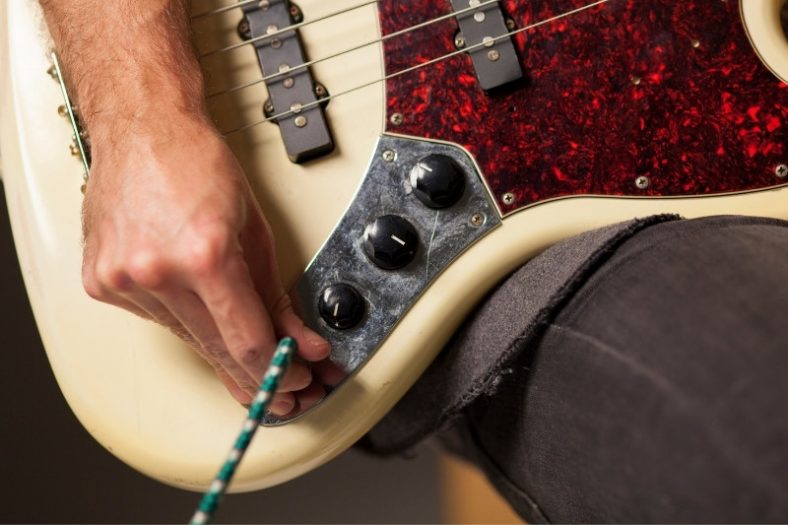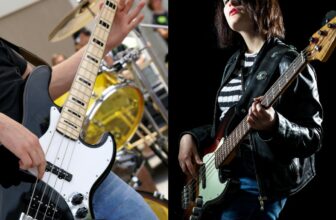Active Vs Passive Bass Guitars – Which Should You Go For?

A passive bass is a normal bass with one tone control and one volume control. An active bass has those as well, but with an additional battery-powered preamp. Simple terms – Passive bass isn’t powered, but an Active bass is.
Trying to make the decision between an active and a passive base is a common dilemma these days. Whether you’re thinking of purchasing a bass, which one should you go for?
The most simple way to explain this is that a passive bass isn’t powered, while an active bass is. This also means that the sound of a passive and an active bass differ, while the passive bass has more of a flat bass sound that’s good for genres like rock, blues and similar to those, an active bass has more of a bright sound so it can be used in funk, metal and so on.
The question is still there, which one should you go for? And the answer to that is, that it all depends on what you want and what kind of genre of music you will be playing.
Passive Bass
A passive bass consists of volume control and tone control. It’s a much simpler bass than an active one. This means that it can’t very well boost your frequencies because it would require more extra power to do so.
The good thing about passive bass is that you don’t have to worry about it producing really irritating high notes or really annoying low notes, because it is set in a more simple way. The passive bass produces a very natural, round, and flat sound for an overall good-sounding bass.
Another good thing to note is, that with a passive bass it’s more unlikely that something will go wrong with its electronics because there are a lot fewer components than with an active bass, there’s less of a chance that something could go wrong.
One of the problems with passive bass is that in the event if you’re using slightly longer cables, the signal might weaken, this is one of the main issues with the passive bass. It can have all kinds of interferences therefore you would adjust your amp to balance out that signal.
In layman’s terms, I’d recommend a passive bass if you’re a beginner. You would use your bass for practicing purposes and not so much as using it for gigs while getting a solid, well-rounded sound, it’s great when starting out and practicing your bass playing chops.
Active Bass
An active bass has volume control, tone control and also consists of a preamp that is powered by a battery. The advantage in power is what sets aside the active bass as a better overall and the passive bass. Having more power means a change in sound to make it sound more bright and strong compared to that of a passive bass.
As was said about the passive bass, long cables being the problem, you don’t have that when you have an active bass. You can use long cables without the worry of losing a signal and that gives you a clearer sound whether you have a longer cable or not.
You can also boost your frequencies with the extra power that equals more eye-opening sounds. It’s more flexible than a passive bass because you have the freedom to play any genre of music that you like, without having to worry about the sound.
The disadvantage of having an active bass is the issues that start to arise when the battery starts to die. This is where the problems begin as the tone starts to drop and thin out and you can start to hear a little distortion coming in.
When this problem occurs, you don’t want to be on stage when it happens. This is really a nerve-wracking feeling and initially, you don’t know where the problem lies until it’s too late.
Which One?
For the decision, I would recommend getting a passive bass if you’re a beginner. This way you don’t have to worry about all the extra components of an active bass and you can just focus on practicing with a well-rounded sound that comes from a passive bass. The long cables won’t be an issue here since you won’t be doing much gigging. A passive bass is more of a home-friendly bass guitar and is more suitable for practicing purposes.
An active bass is also useful if you’re just starting out, but with all the extra components with the additional preamp, I would recommend the active bass for more experienced players that also do gigs. That way, they have more flexibility in their sound and can also play any kind of genre they want, an active bass can give you just that.
Summary
The passive bass is much simpler than an active bass. It has one volume control and one term control. While it can’t boost frequencies, it does have a well-rounded sound without having to worry about it producing irritating high notes or low notes. Basically, it gives a natural flat sound. One of the main issues is that when using long cables with a passive bass, there can be all kinds of interferences with the signal and this will require you to balance that signal out by increasing the volume on your amp. Overall, the passive bass is better for beginners.
An active bass is a powered bass that has a volume control, a tone control, but also has a preamp function that’s powered by a battery. This essentially means more flexibility in sound, giving it a bit more bright feeling as well as not having issues with using longer cables. You can boost your frequencies with that extra power and you can play any genre of music that you prefer. The only problem with the active bass is when the battery starts to die out, your tone starts to drop and distortion starts creeping in. Overall, the active bass is better suited for more experienced players that do gigs.





